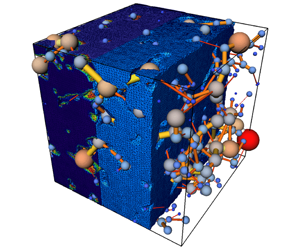Crossref Citations
This article has been cited by the following publications. This list is generated based on data provided by
Crossref.
Ding, Yu
Zhang, Jia-sheng
Jia, Yu
Chen, Xiao-bin
Wang, Xuan
and
Meng, Fei
2020.
Study on Two-Phase Fluid-Solid Coupling Characteristics in Saturated Zone of Subgrade Considering the Effects of Fine Particles Migration.
Applied Sciences,
Vol. 10,
Issue. 21,
p.
7539.
Davydzenka, Tsimur
Fagbemi, Samuel
and
Tahmasebi, Pejman
2020.
Wettability control on deformation: Coupled multiphase fluid and granular systems.
Physical Review E,
Vol. 102,
Issue. 1,
Gu, Qingqing
Liu, Haihu
and
Wu, Lei
2021.
Preferential imbibition in a dual-permeability pore network.
Journal of Fluid Mechanics,
Vol. 915,
Issue. ,
Barbosa, Luis Alfredo Pires
Gerke, Kirill M.
and
Gerke, Horst H.
2022.
Modelling of soil mechanical stability and hydraulic permeability of the interface between coated biopore and matrix pore regions.
Geoderma,
Vol. 410,
Issue. ,
p.
115673.
Zhang, HouLin
Yu, Hao
Yuan, XinHeng
Xu, HengYu
Micheal, Marembo
Zhang, JiaNing
Shu, HongLin
Wang, GaoCheng
and
Wu, HengAn
2022.
Permeability prediction of low-resolution porous media images using autoencoder-based convolutional neural network.
Journal of Petroleum Science and Engineering,
Vol. 208,
Issue. ,
p.
109589.
Zhang, HouLin
Yu, Hao
Meng, SiWei
Huang, MengCheng
Micheal, Marembo
Su, Jian
Liu, He
and
Wu, HengAn
2022.
Fast and accurate reconstruction of large-scale 3D porous media using deep learning.
Journal of Petroleum Science and Engineering,
Vol. 217,
Issue. ,
p.
110937.
Zhang, HouLin
Yu, Hao
Wang, Quan
Xu, WenLong
Huang, MengCheng
Li, FanDing
and
Wu, HengAn
2023.
How to achieve the fast computation for voxel-based irregular structures by few finite elements?.
Extreme Mechanics Letters,
Vol. 65,
Issue. ,
p.
102103.
Tahmasebi, Pejman
2023.
Album of Porous Media.
p.
123.
Wang, Daigang
Liu, Fangzhou
Sun, Jingjing
Li, Yong
Wang, Qi
Jiao, Yuwei
Song, Kaoping
Wang, Shu
and
Ma, Ruicheng
2023.
Lattice-Boltzmann simulation of Two-phase flow in carbonate porous media retrieved from computed Microtomography.
Chemical Engineering Science,
Vol. 270,
Issue. ,
p.
118514.
Yalamanchi, Pydiraju
and
Datta Gupta, Saurabh
2024.
Estimation of pore structure and permeability in tight carbonate reservoir based on machine learning (ML) algorithm using SEM images of Jaisalmer sub-basin, India.
Scientific Reports,
Vol. 14,
Issue. 1,
Wang, Chunqi
Yao, Jun
Wang, Xiaoyu
Huang, Zhaoqin
Xu, Quan
Liu, Fugui
and
Yang, Yongfei
2024.
PORE STRUCTURE AND PERMEABILITY EVOLUTION OF POROUS MEDIA UNDER IN SITU STRESS AND PORE PRESSURE: DISCRETE ELEMENT METHOD SIMULATION ON DIGITAL CORE
.
Journal of Porous Media,
Vol. 27,
Issue. 8,
p.
45.
Wang, Chunqi
Yao, Jun
Huang, Zhaoqin
Liu, Fugui
and
Yang, Yongfei
2024.
Digital core reconstruction based on discrete element and Markov chain-Monte Carlo methods.
Geoenergy Science and Engineering,
Vol. 236,
Issue. ,
p.
212422.



